#colonial singapore
Explore tagged Tumblr posts
Text
#tamil indentured history#colonial malaya#colonial singapore#tamil railway workers#malayan railway history#temples in colonial malaya#temples in colonial singapore#caste feudalism#tamils in southeast asia
20 notes
·
View notes
Text
Hi everyone! I just started this blog today to post progress on my otome game entitled ‘The Founder(s) of Singapore’.
The game features the gijinka (anthropomorphism) of Singapore and her being founded a city by the early founders, Stamford Raffles and William Farquhar. Each founder’s devotion to developing Singapore as a country and being recognised as its founder is represented by their closing relationship with Singapore.
This game will be made with a lot, a lot of research, and I will be making the story as historically accurate as possible, down to researching on what daily life would have been like for them, and information about their attendants and the people close to them, as well as the type of outfits worn by the people of that era.
I’ve been reading online articles, watching videos, and even looking up firsthand sources on the National Archives of Singapore for the sake of my research to gain a deep understanding of the background of that era and what life was like in the past.
The game will predominantly feature Farquhar in it, not because I planned so from the start, but because I realised that Raffles was actually absent from Singapore most of the time between 1819-1823, so he would not have as much of an opportunity to appear in the game. In fact, Raffles only visited Singapore thrice, and his 3 visits didn’t add up to even 10 months, compared to Farquhar’s 4 years or so. Also, Farquhar is often under-appreciated and overshadowed by his boss, so I hope I give him some more recognition as a founder of Singapore through my game.
Please look forward to updates on this blog.
#Singapore#otome game#raffles#Farquhar#Stamford raffles#William Farquhar#visual novel#TyranoBuilder#historical#Singapore history#colonial Singapore
3 notes
·
View notes
Text
Book Notes: Singapore Sapphire
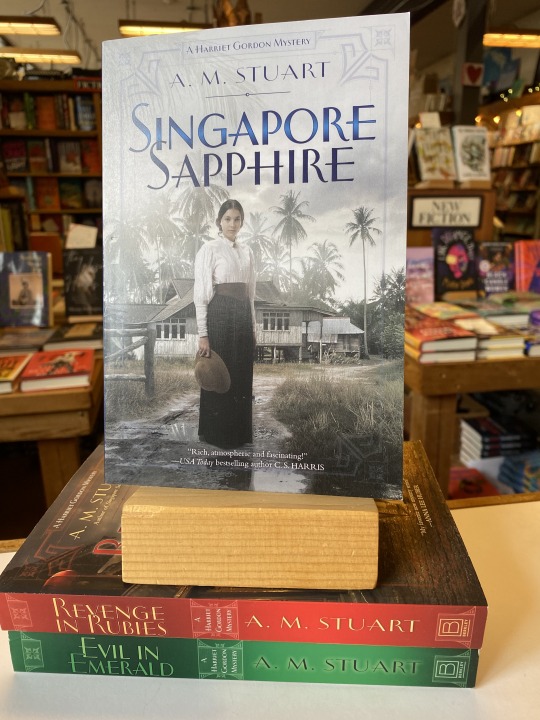
Anyone who has asked me for help in the mystery section of Island Books knows that, with very few exceptions (Louise Penny and Ann Cleeves), I do not read contemporary mysteries. I prefer any bloody murder to be at a historical remove. But I also realized, after combing through my reading journal, I’ve primarily read mysteries set in Regency London. Or World War I London. Or post-WWII London. The common denominator apparently being historical London. So when I visited the meticulously curated Lopez Bookshop last fall, I took a chance on expanding my comfort zone with the delightfully titled Singapore Sapphire, by A.M. Stuart, a historical mystery set in turn of the century colonial Singapore.
This series focuses on the widowed Harriet Gordon, who has joined her brother in Singapore following a traumatizing imprisonment in England due to involvement in the suffragette movement. In changing scene to Singapore, Harriet is hoping to put her past behind her and move amongst people who don’t know her history. To earn a bit of money, she offers her services as a confidential personal secretary. Unfortunately she discovers her first client, Sir Oswald Newbold, dead in his home only a day after their first appointment. When the police arrive, Inspector Robert Curran realizes that Harriet is an asset to the case with her keen eye for detail and a practicality honed by years living at the far reaches of the British Empire. He finds himself drawing more and more on her observations, and after another death is connected to Sir Oswald, Curran can’t help but lean on Harriet to help him untangle a dangerous web of deception.
Branching out to colonial Singapore from London felt like I was pushing myself a little, even though the main characters were still Brits. Stuart does a wonderful job of evoking her setting and describing the variety of people from around the world trying to make their way, however unsavory, in Singapore. Mystery series that hold my interest tend to contain central characters with an engaging partnership. With Harriet and Curran, their friendship and trust in each other slowly evolves while they put together the pieces of the murder. Stuart also lays the groundwork for longer character arcs, leaving me eager to start the next in the series.
I raced through the subsequent books, Revenge in Rubies and Evil in Emeralds, The final book in the series has a title, Terror in Topaz, but sadly no publication date yet. For those of you who are fond of historical mysteries like I am, give the Harriet Gordon series a try!
— Lori
#island books#lori robinson#a. m. stuart#singapore sapphire#revenge in rubies#evil in emeralds#historical mysteries#colonial singapore#lopez bookshop#booknotes
3 notes
·
View notes
Text
🇺🇸⚔️🇨🇳. 🚨
UNITED STATES SENATOR DOESNT KNOW THE DIFFERENCE BETWEEN CHINA AND SINGAPORE
📹 U.S. Senator Tom Cotton (R-AR) questions the CEO of TikTok U.S., Shou Zi Chew, a Singaporian national, about his nationality and affiliations with the "Chinese Communist Party," an entity that does not actually exist.
Chew repeatedly states his nationality and history as a Singaporian, having served in the military, and mentions his loyalty to his home country before Senator Cotton begins ranting about the events of Tiananmen Square in 1989.
#source
@WorkerSolidarityNews
#united states#us senator#us news#us ignorance#us imperialism#us colonialism#singapore#singaporian#tiktok#tiktok us#us wars#us war with china#tom cotton#republicans#us obsession with china#politics#news#geopolitics#world news#global news#international news#china#communist party of china#breaking news#current events
237 notes
·
View notes
Text




Kingdom of Singapura
A Malay Hindu-Buddhist nation that was thought to have been established and founded by the Fabled Raja Sang Nila Utama, a Prince from what is now Palembang, Indonesia.
The Kingdom lasted from 1299 to 1398, his Skin Dark Red symbolising his origin as a Simple Settlement and former Vassal to the Majaphait Empire known as Temasek. Lion ears and a Swordfish Tail, symbolizing the Lion that the Raja saw, the Merlion and the Swordfish invasion myth.
The Clothes and accessories he wears represent his past and his conflicts, the Crown he wears is woven by Leaf fronds and Tree bark, referencing the Orang Asli of East Malaysia and Singapore.
I commissioned this piece from hshmingon on Instagram!
Go support them!
#art#commissioned art#countryhumans#singapore#countryhumans singapore#Kingdom of Singapura#pre colonial period#medieval fantasy#medieval history#historical fantasy#majapahit#ayutthaya#malaysia#orang asli
12 notes
·
View notes
Text
Happy #WorldBinturongDay!
This watercolor is from the William Farquhar Collection of Natural History Drawings, a collection of 477 images of native biota of the Malay Peninsula by anonymous Chinese artists commissioned between 1803-18:

Binturong, c. 1803-1818 Anonymous Chinese artist William Farquhar Collection of Natural History Drawings National Museum of Singapore
More on the blog:
#Binturong#Bearcat#IUCN Red list#mammals#National Museum of Singapore#viverrid#William Farquhar Collection of Natural History Drawings#World Binturong Day#Southeast Asian art#Asian art#Chinese art#watercolor#Malay Peninsula#animal holiday#illustration#painting#natural history art#scientific illustration#Colonial art
135 notes
·
View notes
Text

My genius is unappreciated in my time
#singapore#stamford raffles#history#history jokes#orientalism#british colonialism#pirates of the caribbean#potc#jack sparrow#clearly you've never been to singapore#recontextualization#recontextualizing#my very own ruminations#posts that make me laugh
13 notes
·
View notes
Text
[S]and has acquired a conspicuous profile in contemporary urbanization over the past two decades. [...] [S]and but also gravel and crushed rock, are the fastest-growing category of extracted material. Their extraction has increased six-fold in the Asia-Pacific region over the last two decades. Singapore, a city-state in Southeast Asia the size of New York City and half the size of London, is the largest per capita importer of sand in the world. The city-state’s urbanization and never-ending construction [...] is partly responsible for its considerable appetite for sand, but this use pales in comparison to the amount it requires for its land reclamation project, which has seen the city-state expand its territory from 585 square kilometers in 1959 to 724 in 2022. Singapore’s construction of territory, and the sand it has imported from all over Southeast Asia to resource its geophysical projection of sovereignty, invites us to consider the implications of urbanization’s enrollment of greater and greater volumes of sediment, and the geopolitics of the global sand crisis. [...]
As sediment flows and locks into place, it expresses characteristics of all three states of matter, depositing and eroding [...]. A geomorphological errantry, sediment is always on the move [...]. In its multiplicity, sand becomes a kind of narrator for those elements [...]. In its modulation [...], sediment sutures together landscapes that are neither solid nor fluid, but the porous interplay [...].
---
Between 2006 and 2016, Singapore, with a population of less than six million, was the top importer of sand in the world four times. Land reclamation there truly began with colonization by the British East India Company, with Boat Quay in 1822, when three hundred or so convict laborers who were paid pittances chopped down hills and cut up stones to embank a swamp, lest it remain fallow. When Singapore became an independent city-state in 1965, reclamation projects initially cut down hills for fill material, flattening the interior and exterior of the main island alike. [...] As these projects grew more expansive and the city-state’s demand for sand intensified, Malaysia and then Indonesia banned sand exports to Singapore [...]. This [resulting] price spike shook the city-state to its core, prompting the opening of a series of construction sand stockpiles [...]. The government began purchasing sand through its web of contractors and subcontractors from Vietnam, Cambodia, the Philippines, and Myanmar. [...]
The securitization of sand in multiple stockpiles in Singapore eerily mirrors what happened in the extractive sandscapes of its origin: similarly sized dunes bloomed along the banks of mangroves in Koh Kong, Cambodia, like a dream herniating into reality, an invasive species of landscape bursting at the seam where the land met the water, still haunting riverbeds years after the dredging stopped. [...]
---
[T]he fantasy of reclaimed land through dubiously sourced rudiments of city-statecraft. [...] This kind of work is normally kept out of sight behind physical partitions as well as the labyrinthine contractual involutions of procurement arrangements, until it is seamlessly assumed by the whole, consumed by land as a homogenous legal entity [...] [B]ehind the mask, another mask. [...] [T]he sand barges and ships enter the maritime waters of Singapore from [...] legally undisclosable sources of its origin.
The eponymous proclamation [...] is the legal mechanism by which a piece of reclaimed land is “proclaimed” as state land proper by the president. A reclamation can only become state land by the text of a proclamation, a eucharistic procedure which purifies the land of its ambiguous sedimentary origin. Prior to that it is foreshore or seabed, but once it has been proclaimed, “thereupon that land shall immediately vest in the State freed and discharged from all public and private rights [...] over the foreshore or the sea-bed before the same were so reclaimed.” [...]
---
The limit to seeing like a state is that the state has a way of doing things that it can’t see, and of refusing to register that which does not meet its threshold of intelligibility.
It blinds itself through the loophole, the nondisclosure agreement, the handshake and its subtle para-political fission. [...]
Singapore’s continued economic prosperity depends on the speculative projection of its territory through unequal economic exchange, disguising it through fabulations of sovereign ingenuity like the Gardens by the Bay. [...]
[There is an] asymmetry between its curated artifice and the remote terraqueous landscapes this curation predates upon, unsettling the ground on which the city-state projects its most delirious fictions of sovereignty [...].
But those very spaces of nondescript hinterland are the logistical and industrial engines which make the Gardens possible. [...]
---
[T]he sheer colonial and postcolonial history of geographic expansion and environmental transformation implies that there are still further worlds to extract for reproducing the global city. Urban form rewired by geo-economic fortune and political repression subversively enroll land and labor into its globe-spanning machinery: it needs to keep on expanding to stay ahead of whatever anticipated global economic movement will buoy it in the future. [...] The transmutation of Singapore’s development trajectory is not historical, but contemporary: Singapore is the global city as a centripetal conjugator of space-time, funneling either term through supply chains that pass through it to produce territory as a plasticity [...].
The calamity it visited on the population of Koh Sralao was first pioneered all over Singapore and its outlying islands in the name of necessity, modernization, and the nation, displacing Orang Laut and Orang Pulau communities, who faced a choice to either abandon their maritime ways or resettle further afield in Malaysia or Indonesia. Many of Singapore’s southern islands were grafted together and erased by land reclamation, with Jurong Island in particular becoming an agglomeration of eighteen different islands, their Malay names now lost, sunk together into the catacombs of a dedicated petrochemical refining and storage complex.
Instead of being haunted by the sediment it has reclaimed its land with, and the rhythms and ecologies this sediment subtended, the global city and its subcontracted tendrils haunt those vestiges of maritime and riverine life bound by sediment like a vengeful ghost, compelled to repeat its actions, and to forget them in the projection of another tabula rasa.
---
All text above by: William Jamieson. “Extracting Sovereignty: Land Reclamation in Southeast Asia and the Emergence of the Global Sand Crisis.” e-flux Journal Issue #137. June 2023. [Bold emphasis and some paragraph breaks/contractions added by me. Presented here for commentary, teaching, criticism.]
#abolition#ecology#imperial#colonial#sand singapore#geographic imaginaries#seeing like a state#threshold of intelligibility#black methodologies#fred moten#tidalectics#carceral geography#ecologies#multispecies#intimacies of four continents
40 notes
·
View notes
Text

"Losing Hearts and Minds is an innovative blend of social and military history that examines how race, gender, and ethnic identities shaped the British army in a colonial setting. This deeply researched, beautifully written book brings to life the tensions within a multi-cultural military, when lines blurred between soldiers and civilians, and nationalist loyalties clashed with imperial subjecthood."
#uwlibraries#history books#history of malaysia#history of singapore#british history#colonial history
6 notes
·
View notes
Text
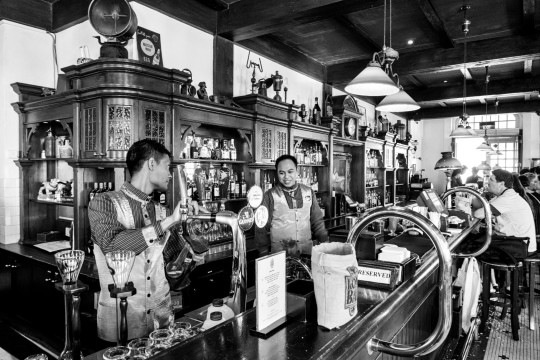
Masters of Singapore Sling
#travelling#Singapore#asia#island#raffles#hotel#long bar#singapore sling#bar#bartenders#monochrome#people#cocktail#colonial
5 notes
·
View notes
Text
Singapore's History and Heritage: A Walk Through Time
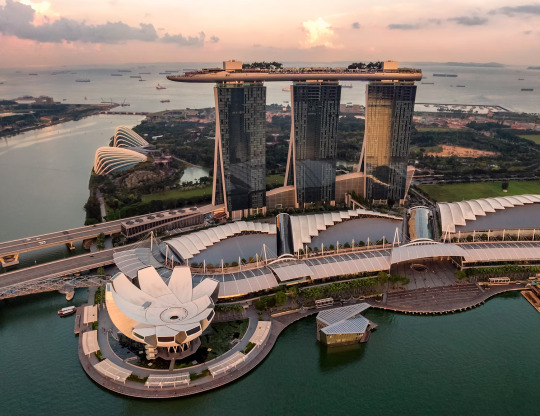
Nestled at the crossroads of Southeast Asia, Singapore is a city-state with a rich tapestry of history and cultural heritage that dates back centuries. From its humble beginnings as a fishing village to becoming a global economic powerhouse, Singapore has undergone a remarkable transformation. Today, the city-state stands as a testament to the harmonious coexistence of tradition and modernity. While exploring the key milestones that have shaped Singapore's history and heritage, visitors can also indulge in various things to do in Pai and experience the vibrant scene of shopping in Thailand.
Early Days: A Fishing Village to a Trading Hub
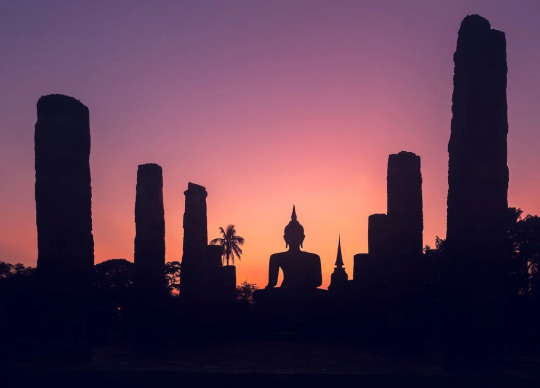
Singapore's story begins in the 14th century when it was a mere fishing village known as Temasek. It wasn't until the arrival of Sang Nila Utama, a Sumatran prince, in the 13th century that the island gained prominence. The prince renamed the island "Singapura," which means "Lion City" in Sanskrit after he allegedly spotted a lion on its shores. Although lions never roamed the island, the name stuck, symbolizing strength and courage.
In the 19th century, Singapore's strategic location at the crossroads of major shipping routes attracted the attention of European powers. Sir Stamford Raffles, the founder of modern Singapore, established a British trading post in 1819. This marked the beginning of Singapore's rapid ascent as a crucial trading hub in the region.
Colonial Era and World War II:

Under British colonial rule, Singapore flourished economically, becoming a melting pot of cultures due to its strategic location and open trade policies. However, the prosperity was interrupted during World War II when the Japanese occupied Singapore from 1942 to 1945. The war left an indelible mark on the island, with the Battle of Singapore being a pivotal moment in its history. After the war, Singapore went through a period of recovery and reconstruction.
Independence and Nation-Building:
The desire for self-governance gained momentum in the post-war era, leading to the formation of the People's Action Party (PAP) in 1954. Led by Lee Kuan Yew, the PAP advocated for independence from British rule and social reforms. Singapore achieved self-governance in 1959 and joined the Federation of Malaysia in 1963. However, the union was short-lived, and Singapore gained full independence on August 9, 1965, due to political differences with Malaysia.
Lee Kuan Yew became the first Prime Minister of Singapore and embarked on a nation-building journey characterized by economic development, social cohesion, and multiracial harmony. The transformation was remarkable, turning Singapore from a developing nation into a first-world city-state within a single generation.
Cultural Diversity: Harmony in Diversity

One of the defining features of Singapore is its multicultural society. The island is a mosaic of different ethnicities, including Chinese, Malay, Indian, and various other communities. This diversity is not only evident in the population but also in the architecture, cuisine, and traditions that permeate the city.
Chinatown, Little India, and Kampong Glam are iconic districts that showcase the cultural richness of their respective communities. Visitors can explore the vibrant markets, temples, mosques, and churches, experiencing firsthand the harmonious coexistence of different faiths and traditions. The annual celebrations of festivals such as Chinese New Year, Deepavali, Hari Raya Puasa, and Christmas further highlight the multicultural tapestry of Singapore.
Preserving Heritage: Museums and Historic Sites

To truly understand Singapore's history and heritage, a visit to its museums and historic sites is essential. The National Museum of Singapore provides a comprehensive overview of the island's past through interactive exhibits and artifacts. Fort Canning Park, with its archaeological sites and lush greenery, offers a glimpse into Singapore's colonial history.
Changi Chapel and Museum pay homage to the prisoners of war during World War II, while the Peranakan Museum celebrates the unique Peranakan culture, born from the intermingling of Chinese and Malay influences. These sites not only preserve the historical significance but also serve as educational platforms for future generations.
Modern Singapore: A Global City-State

In the latter half of the 20th century, Singapore transitioned from a trading post to a global economic powerhouse. Its commitment to education, innovation, and infrastructure development propelled the nation into the ranks of the world's most developed countries. The skyline of Singapore reflects its modernity, with iconic structures like the Marina Bay Sands and Gardens by the Bay becoming symbols of the city-state's progress.
Conclusion:
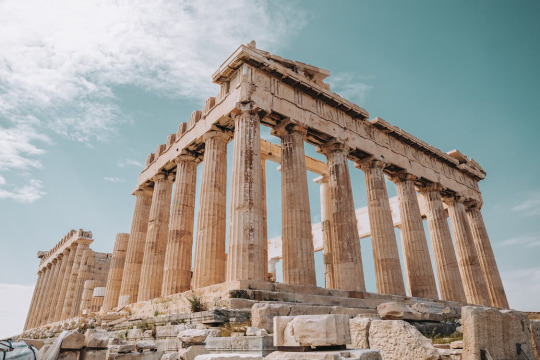
Singapore's history and heritage are intertwined with resilience, diversity, and a forward-looking spirit. As visitors traverse the city-state, they embark on a journey through time, witnessing the transformation from a humble fishing village to a global metropolis. Singapore's ability to preserve its cultural roots while embracing progress serves as an inspiration for nations worldwide. A walk through the Lion City is not just a stroll through its bustling streets but a fascinating exploration of a nation's evolution, where history and heritage seamlessly coalesce.
#Singapore History#Cultural Heritage#Lion City#Southeast Asian History#Colonial Era#Independence#Nation-Building#Multicultural Society#Chinatown#Little India#Kampong Glam#Museums in Singapore#National Museum#Fort Canning Park#World War II History#Changi Chapel and Museum#Peranakan Culture#Modern Singapore#Global City-State#Marina Bay Sands
2 notes
·
View notes
Text
Thinking about peranakan hws singapore
#hetalia#hws singapore#aph singapore#despite what colonial narratives want to lean towards singapore wasnt. uninhabited before the british#chews i would elaborate but i dont have the time rn........ maybe in another post#baba singapore lives in my heart tho
7 notes
·
View notes
Text
Wish there was a historical reenactment live-action film of Raffles and Farquhar and colonial Singapore. Wonder why nobody has produced one by now. I would think that this would be the sort of thing the ministry of education or culture would fund, in order to educate the public of the history of Singapore.
#Singapore#Singapore history#Stamford raffles#raffles#William Farquhar#Farquhar#colonial singapore#film#Singapore film
0 notes
Text
Alfian: I agree completely. About coming to terms with our colonial legacy. Unless we are attentive to the scars that colonialism has left behind, we really run the risk of becoming an imperial entity ourselves. And I already see this happening. In terms of say, extraction of sand from other countries. In terms of how we are degrading their coastlines, disrupting fishing grounds and polluting waters. I think that, for me, is a very clear example of this imperial form of extraction and exploitation. Just to benefit our own construction industries, to expand our own coastlines, we are destroying these particular coastal ecosystems in other countries. I think this is already happening right now in Cambodia. Previously it was happening in Malaysia and Indonesia, until they instituted sand export bans, in 1997 and 2007 respectively. Which just shows you how serious the problem is. And I think in Singapore, because we're one of the richest countries in Southeast Asia, and because we're such a centre for capital, and capital accumulation, I really worry that because of this disparity between us and our neighbours, we start doing certain things which are very colonial. And more than doing, we start to think in very colonial ways. And I think this is one of the greatest dangers, which is that being the product of so-called 'colonial enlightenment, we then believe in certain colonial ideas such as racial hierarchies of difference. Hai Bin: And we take it to be the norm. Alfian: So we think that oh, our Southeast Asian neighbours around us, they're not doing so well economically, because biologically, brown people are not hardworking, blah, blah, blah. Or there's environmental determinism at work, which is if you're born in the tropics, you haven't suffered hardship like cold winters in temperate climes. So you're not hardy, you're complacent, you're soft. I mean, Lee Kuan Yew thinks like this. A lot of his racial ideas are actually very, very colonial. But then mapped onto an Anglo-Chinese superiority. A neo-colonial figure. Sometimes we feel that it's very distant, but actually it still haunts us, it's very present. The spectres of colonialism are still with us. And the migrant worker issue for me is a classic example of how we treat labour. Because there are echoes, and I think we can trace this to the British use of convict labour from India to come and build basically the entire downtown area. North and South Bridge Road, St Andrew's Cathedral, Commercial Square?-all convict labour. This was labour that you could really exploit, almost practically slave labour. But the excuse is that, these people have a debt to pay to the state because of their criminality. You put it in that framework and you extract as much forced or slave labour as possible. It's similar with migrant workers when you put them in a framework of, "Oh, they are better off here than in their own countries where they wouldn't have found work anyway." And therefore this justifies us either giving them the minimum welfare treatment, or underpaying them, or giving them substandard housing and food. So I think the minute you frame it in certain ways… so for the British they framed convict labour as, "Oh these are prisoners, so there are certain rights they don't deserve." And for migrant workers we frame it as, "Oh these migrants have come to a better place and they can't have everything so there are certain rights that we must deny them." But this delusion that we are doing migrant workers a favour by 'rescuing' them from unemployment, and that they should be grateful and not ask for anything else, it's a colonial way of thinking. It's how so much exploitation and theft occurred under the self-deception that colonisers were bringing the light of civilisation to benighted natives.
---"We Refuse to Recognise the Trauma". A Conversation Between Alfian Sa'at and Neo Hai Bin, from Raffles Renounced: Towards a Merdeka History, edited by Alfian Sa'at, Faris Jorami and Sai Siew Min
3 notes
·
View notes
Text
some things are implied i think by the spirit of the 20th century being a british woman
#jenny sparks#aaaaAAAAAAAAAAAA#im not like. smart tm or whatever about this stuff and i doubt it was intentional buuuut i do wonder about the correlation between jenny's#life going to hell + her retreat to the sidelines of history and the decline of the empire. youd be hard pressed to not have jenny q born i#a former british colony but ohhhh something about singapore in particular. i need to read more books before i can really articulate this bu#theres something to examine. i think. makes jenny and shens relationship weird as well. everything gets weird. can anyone hear me
1 note
·
View note
Text
The beauty of Adam Park
Adam Park is a beautiful colonial residential estate that was recently in the news, having been earmarked for conservation. Built from 1928 to 1932, the estate’s 19 residences housed Singapore Improvement Trust (SIT) and Municipal officers. The residences are among 500 residences that have been described as ‘black and white’ houses. The common term relates more to their appearance, rather than…
#Adam Park#Architecture#Battle Sites#Black and White Houses#Colonial Architecture#Colonial Residences#Old Places#Old Singapore#Photographs#Photography#Second World War#Singapore#War Sites#World War II#World War Two
1 note
·
View note